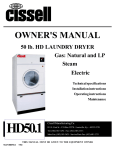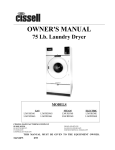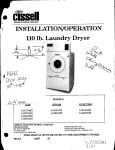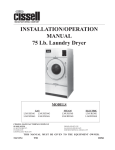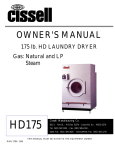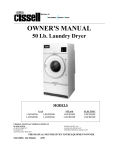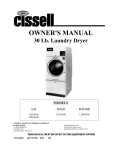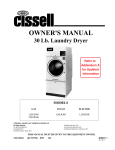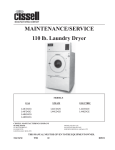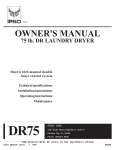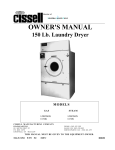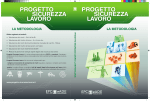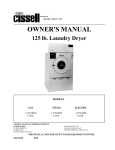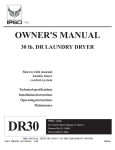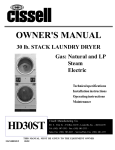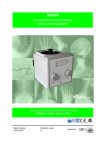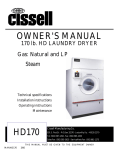Download Cissell MANHD75ST Owner`s manual
Transcript
OWNER'S MANUAL 75 lb. HD STACK LAUNDRY DRYER Gas: Natural and LP Steam HD75ST Cissell Manufacturing Co. 831 S. First St. - P.O.Box 32270 - Louisville, Ky. - 40232-2270 Tel: (502) 587-1292 - Fax: (502) 585-2333 Sales Fax: (502) 585-3625 - Service/Parts Fax: (502) 681-1275 THIS MANUAL MUST BE GIVEN TO THE EQUIPMENT OWNER Page 1 MANHD75ST 05/02 IMPORTANT NOTICES—PLEASE READ For optimum efficiency and safety, we recommend that you read the manual before operating the equipment. Store this manual in a file or binder and keep for future reference. WARNING: For your safety, the information in this manual must be followed to minimize the risk of fire or explosion or to prevent property damage, personal injury or loss of life. - Do not store or use gasoline or other flammable vapors or liquids in the vicinity of this or any other appliance. - WHAT TO DO IF YOU SMELL GAS • • • • • Do not try to light any appliance. Do not touch any electrical switch; do not use any phone in your building. Clear the room, building or area of all occupants. Immediately call your gas supplier from a neighbor's phone. Follow the gas supplier's instructions. If you cannot reach your gas supplier, call the fire department. Installation and service must be performed by a qualified installer, service agency or the gas supplier. WARNING: In the event the user smells gas odor, instructions on what to do must be posted in a prominent location. This information can be obtained from the local gas supplier. WARNING: Wear safety shoes to prevent injuries. WARNING: Purchaser must post the following notice in a prominent location: FOR YOUR SAFETY Do not store or use gasoline or other flammable vapors and liquids in the vicinity of this or any other appliance. WARNING: A clothes dryer produces combustible lint and should be exhausted outside the building. The dryer and the area around the dryer should be kept free of lint. WARNING: Be safe, before servicing machine, the main power should be shut off. Page 2 WARNING: To avoid fire hazard, do not dry articles containing foam rubber or similar texture materials. Do not put into this dryer flammable items such as baby bed mattresses, throw rugs,undergarments (brassieres, etc.) and other items which use rubber as padding or backing. Rubber easily oxidizes causing excessive heat and possible fire. These items should be air dried. WARNING: Synthetic solvent fumes from drycleaning machines create acids when drawn through the dryer. These fumes cause rusting of painted parts, pitting of bright or plated parts, and completely removes the zinc from galvanized parts, such as the tumbler basket. If drycleaning machines are in the same area as the tumbler, the tumbler's make-up air must come from a source free of solvent fumes. WARNING: Do not operate without guards in place. WARNING: Check the lint trap often and clean as needed but at least a minimum of once per day. WARNING: Alterations to equipment may not be carried out without consulting with the factory and only by a qualified engineer or technician. Only Manufacturer parts may be used. WARNING: Remove clothes from dryer as soon as it stops. This keeps wrinkles from setting in and reduces the possibility of spontaneous combustion. WARNING: Be safe - shut main electrical power and gas supply off externally before attempting service. WARNING: Never use drycleaning solvents, gasoline, kerosene, or other flammable liquids in the dryer. FIRE AND EXPLOSION WILL OCCUR. NEVER PUT FABRICS TREATED WITH THESE LIQUIDS INTO THE DRYER. NEVER USE THESE LIQUIDS NEAR THE DRYER.. WARNING:Do not place items exposed to cooking oils in your dryer. Items contaminated with cooking oils may contribute to a chemical reaction that could cause a load to catch fire. WARNING: Never let children play near or operate the dryer. Serious injury could occur if a child should crawl inside and the dryer is turned on. WARNING: Never tumble fiberglass materials in the dryer unless the labels say they are machine dryable. Glass fibers break and can remain in the dryer. These fibers cause skin irritation if they become mixed with other fabrics. WARNING: Before operating gas ignition system - purge air from natural gas or propane gas lines per manufacturer’s instructions. WARNING: To reduce the risk of electric shock, disconnect this appliance from the power supply before attempting any user maintenance other than cleaning the lint trap. Turning the controls to the OFF position does not disconnect this appliance from the power supply. Page 3 ATTENTION: L’ACHETEUR DOIT PLACER L’AVERTISSEMENT SUIVANT DANS UN ENDROIT CLAIR ET VISIBLE: AVERTISSEMENT. Assurez-vous de bien suivre les instructions donnees dans cette notice pour reduire au minimum le risque d’incendie ou d’explosion ou pour eviter tuot dommage materiel, toute blessure ou la mort. __ Ne pas entreposer ni utiliser d’essence ni d’autres vapeurs ou liquides inflammables dans le voisinage de cet appareil ou de tout autre apparell. __ QUE FAIRE SI VOUS SENTEZ UNE ODEUR DE GAZ: • Ne pas tenter d’allumer d’apparell. • Ne touchez a aucun interrupteur. Ne pas vous servir des telephones se trouvant dans le batiment ou vous vous trouvez. • Evacuez la piece, le batiment ou la zone. • Appelez immediatement votre fournisseur de gaz depuis un voisin. Suivez les instructions du fournisseur. • Si vous ne pouvez rejoindre le fournisseur de gaz, appelez le service des incendies. __ l’installation et l’entretien doivent etre assures par un installateur ou un service d’entretien qualifie ou par le fournisseur de gaz. ATTENTION: L’ACHETEUR DOIT PLACER L’AVERTISSEMENT SUIVANT DANS UN ENDROIT CLAIR ET VISIBLE: POUR VOTRE SECURITE Ne pas entreposer ni utiliser d’ essence ni d’autres vapeurs ou liquides inflammables dans le voisinage de cet appareil ou de tout autre appareil. Page 4 CISSELL DRYER WARRANTY The Cissell Manufacturing Company (Cissell) warrants all new equipment (and the original parts thereof) to be free from defects in material or workmanship for a period of three (3) years from the date of sale thereof to an original purchaser for use, except as hereinafter provided. With respect to non-durable parts normally requiring replacement in less than three (3) years due to normal wear and tear, and with respect to all new repair or replacement parts for Cissell equipment for which the three (3) year warranty period has expired, or for all new repair or replacement parts for equipment other than Cissell equipment, the warranty period is limited to ninety (90) days from date of sale. The warranty period on each new replacement part furnished by Cissell in fulfillment of the warranty on new equipment or parts shall be for the unexpired portion of the original warranty period on the part replaced. With respect to electric motors, coin meters and other accessories furnished with the new equipment, but not manufactured by Cissell, the warranty is limited to that provided by the respective manufacturer. Cissell’s total liability arising out of the manufacture and sale of new equipment and parts, whether under the warranty or caused by Cissell’s negligence or otherwise, shall be limited to Cissell repairing or replacing, at its option, any defective equipment or part returned f.o.b. Cissell’s factory, transportation prepaid, within the applicable warranty period and found by Cissell to have been defective, and in no event shall Cissell be liable for damages of any kind, whether for any injury to persons or property or for any special or consequential damages. The liability of Cissell does not include furnishing (or paying for) any labor such as that required to service, remove or install; to diagnose troubles; to adjust, remove or replace defective equipment or a part; nor does it include any responsibility for transportation expense which is involved therein. The warranty of Cissell is contingent upon installation and use of its equipment under normal operating conditions. The warranty is void on equipment or parts; that have been subjected to misuse, accident, or negligent damage; operated under loads, pressures, speeds, electrical connections, plumbing, or conditions other than those specified by Cissell; operated or repaired with other than genuine Cissell replacement parts; damaged by fire, flood, vandalism, or such other causes beyond the control of Cissell; altered or repaired in any way that effects the reliability or detracts from its performance, or; which have had the identification plate, or serial number, altered, defaced, or removed. No defective equipment or part may be returned to Cissell for repair or replacement without prior written authorization from Cissell. Charges for unauthorized repairs will not be accepted or paid by Cissell. CISSELL MAKES NO OTHER EXPRESS OR IMPLIED WARRANTY, STATUTORY OR OTHERWISE, CONCERNING THE EQUIPMENT OR PARTS INCLUDING, WITHOUT LIMITATION, A WARRANTY OF FITNESS FOR A PARTICULAR PURPOSE, OR A WARRANTY OF MERCHANTABILITY. THE WARRANTIES GIVEN ABOVE ARE EXPRESSLY IN LIEU OF ALL OTHER WARRANTIES, EXPRESS OR IMPLIED. CISSELL NEITHER ASSUMES, NOR AUTHORIZES ANY PERSON TO ASSUME FOR IT, ANY OTHER WARRANTY OR LIABILITY IN CONNECTION WITH THE MANUFACTURE, USE OR SALE OF ITS EQUIPMENT OR PARTS. For warranty service, contact the Distributor from whom the Cissell equipment or part was purchased. If the Distributor cannot be reached, contact Cissell. IDENTIFICATION NAMEPLATE The Identification Nameplate is located on the rear wall of the dryer. It contains the dryer serial number, product number, model number, electrical specifications and other important data that may be needed when servicing and ordering parts, wiring diagrams, etc. Do not remove this nameplate. Page 5 TABLE OF CONTENTS 75 LB. STACK LAUNDRY DRYER PAGE PAGE Model Numbers & Company Address ......................................... 1 Direct Spark Ignition Flow Chart ................................................ 32 Important Notices ...................................................................... 2-4 General Maintenance ................................................................. 33 Dryer Warranty ............................................................................ 5 Basket Alignment - Double Motor Model ................................... 34 Table of Contents ......................................................................... 6 Shimming the Basket and Spider Assembly ................................ 35 Warnings, Cautionary Notes and Symbols ................................. 7-8 Air Switch Adjustment ............................................................... 36 Unpacking and General Installation ......................................... 9-10 Fan Rotation ............................................................................... 37 Dryer Outline Dimensions (Illustration) ...................................... 11 Dryer - Front View ............................................................... 38-39 General Specifications ................................................................ 12 Dryer - Rear View ................................................................ 40-41 Motor List ................................................................................... 13 Thermostat Assembly ............................................................ 42-43 General Information .................................................................... 14 Front Panel and Door Assembly - OPL ..................................... 44 Gas Pipe Size Chart .................................................................... 15 Front Panel Asm. - OPL - Reed Switch ..................................... 45 Gas Piping Information ............................................................... 16 Front Panel Asm. - Coin - Reed Switch ..................................... 46 Gas Service Installation Information ........................................... 17 Motor Control Box Assembly ..................................................... 47 Exhaust Installation - Multiple Manifold Duct ........................ 18-20 Exhaust Duct Assembly ............................................................. 48 Dryer Make-Up Air Requirements ............................................. 21 Air Switch Assembly .................................................................. 49 Exhaust Installation with Separate Ducts .................................... 22 Gas Heating Unit ........................................................................ 50 Exhaust and Venting ................................................................... 23 Timer Control Panel Assembly ................................................... 51 Rules for Safe Operation of Dryer ............................................. 24 DMPC Control Panel Assembly ................................................. 52 Operating Instructions - Two Timer Model ................................ 25 DMP Control Panel Assembly ................................................... 53 Service Savers ............................................................................ 26 DX3C Control Panel Assembly .................................................. 54 Troubleshooting ..................................................................... 27-30 Small Gear Reducer Assembly - TM100 .................................... 55 Direct Spark Ignition (DSI) System ............................................ 31 Page 6 SYMBOLS The following symbols are used in this manual and/or on the machine. The numbers between () refer to the numbers on the machine surveys. Symbol Description NOTE! Hot! Do Not Touch Heib! Nicht Beruhren Haute temperature! Ne pas toucher Caliente! no tocar Heet! Niet Aanraken dangerous voltage tension dangereuse Gafahrliche elektrische Spannung tension peligrosa on marche Ein conectado off arrêt Aus desconectado start demarrage Start arranque de un movimiento emission of heat in general êmission de chaleur en general Warmeabgabe allgemein emisión de calor cooling refroidissement Kuhlen enfriamiento Page 7 Part/Measurement SYMBOLS The following symbols are used in this manual and/or on the machine. Symbol Description rotation in two directions rotation dans les deux sens Drehbewigung in zwei Richtungen movimiento rotativo en los dos sentidos direction of rotation sens de mouvement continu de rotation Drehbewegung in Pfeilrichtung movimiento giratorio o rotatorio en el sentido de la flecha End of Cycle caution attention Achtung atencion; precaucion Page 8 Unpacking/General Installation (All Dryers) UNPACKING This dryer is packed in a large (heavy-duty) protective wooden crate. Upon arrival of the equipment, any damage in shipment should be reported to the carrier immediately. Upon determining permanent location of a unit, care should be taken in movement and placement of equipment. To move dryer through door ways, you may need to remove the top of the machine. Follow instruc tions for disassembling. See outline clearance diagrams for correct dimensions. Remove all packing material such as: tape, manuals, skid, etc. Check voltage and amperes on rating plate before installing the dryer. GENERAL INSTALLATION (ALL DRYERS) IMPORTANT Before installing or operating this dryer, thoroughly read the owner's manual for correct instructions concerning electric connections, exhaust ducting, gas piping, steam connections, make-up air, etc. IMPORTANT Read the warnings in this manual. IMPORTANT Do not install this dryer in an area where it will be exposed to water and/or weather. IMPORTANT Failure to follow these instructions and warnings may create a safety hazard and may affect the warranty. IMPORTANT Follow all local codes. IMPORTANT If you have any installation questions, consult the factory Service Department. Page 9 General Installation (All Dryers) GENERAL INSTALLATION (ALL DRYERS) Position dryer for the least amount of exhaust piping and elbows, and allow free access to the rear of dryer for future servicing of belts, pulleys and motors. Installation clearance from all combustable material for gas dryers is 0” ceiling clearance, 24” rear clearance, and 0” side clearance. Installation clearance from all combustable material for steam dryers is 0” ceiling clearance, 24” rear clearance, and 0” side clearance. Before operating dryer, open basket door and remove blocking between front panel and basket. Read the instruction tags, owner's manual, warnings, etc. GENERAL IMPORTANT REPLACEMENT PARTS The dryer is so designed that when an operator opens the dryer door, the basket and exhaust fan stop. Hot, dry air is properly and effectively moved through the basket and exhausted through a lint trap to the venting and eventually to the atmosphere. The lint accumulates in the collector and should be removed as needed, minimum once daily. IMPORTANT Provide adequate clearance for air openings into the combustion chamber. Replacement parts for this dryer are available from your distributor or by contacting the factory at the address or phone number printed on the cover of this manual. WARNING Unit is heavy! NOTE The gas installation must conform with local codes or, in the absence of local codes, with the National Fuel Gas Code, ANSI Z223.1 or the CAN/CGA-B149, Installation Codes. Page 10 75 lb. STACK DRYER Outline Dimensions Page 11 General Specifications GENERAL SPECIFICATIONS FOR 75 lb. STACK LAUNDRY DRYERS Basket Load cket Floor Space ....................................... 87-1/2” (2223 mm) H x 54” (1372 mm) W x 63-1/2” (1613 mm) Deep Basket Size ........................................ 36” (915 mm) Diameter x 36” Deep—21 cu. ft. (600 liter) Exhaust Duct ...................................... 12” Diameter (305 mm) Motor Sizes ....................................... Fan—1/2 HP; Basket —1 HP Maximum Air Displacement.............. 2000 cfm (56.63 m³/min.) total (both pockets) Recommended Operating .................. 1576-1826 cfm Range (44.63 - 51.71 m³/min.) total (both pockets) Net Weight (approx.)......................... 1810 lbs. (821 kg.) Domestic Shipping Weight ................ 1960 lbs. (889 kg.) (carton) Export Shipping Dimensions ............. 93” L (2363 mm) x 57” W (1448 mm) x 76” H (1931 mm) Export Crating ................................... 233 cu. ft. (6.6 m³) Basket RPM ...................................... Reversing—40 (3.2 reversals per minute) Non-Reversing—40 Gas Supply ........................................ 3/4” PipeConnection(26 mm) Gas Pressure Regulator ..................... Set at 3.5” (Natural Gas) WaterColumn(8.7 mbar) GAS FIRED MODEL BTU Input (4 burners) ....................... 360,000 Btu/hr (90,720 kcal/h) (Natural Gas) 360,000 Btu/hr (90,720 kcal/h) (LP Gases) Electronic Ignition ............................. Direct Spark Ignition Drying Time (approx.) ...................... 75 lbs. (35 kg) Dryweight per pocket (Indian Head Cloth) 70% Moisture Retention— 32 minutes Page 12 Motor List DOUBLE MOTOR MODELS Motor No. Voltage Hz. Phase MTR303 200-240/460 60 3 MTR303 220/380 60 MTR301 115/200-240 MTR303 Basket/Fan HP Amps RPM B 1 3.2/1.6 1725 3 B 1 3.2/1.6 1725 50 1 B 1 9.0/4.9 1425 200/346 50 3 B 1 3.2/1.6 1425 MTR303 220/380 50 3 B 1 3.2/1.6 1425 MTR303 240/415 50 3 B 1 3.2/1.6 1425 MTR101 575 60 3 B/F 1 1.7 1725 MTR300 115/200-240 60 1 F 1/2 6.2/3.1 1725 MTR302 200-240/460 60 3 F 1/2 1.8/0.9 1725 MTR302 220/380 60 3 F 1/2 1.8/0.9 1725 MTR300 115/200-240 50 1 F 1/2 6.2/3.1 1425 MTR302 200-220/346-380 50 3 F 1/2 1.8/0.9 1425 MTR184 240/415 50 3 F 1/3 1.6/.90 1425 Page 13 General Information GENERAL INFORMATION The dryer is so designed that when an operator opens the dryer door, the basket stops. You can expect fast drying from a laundry dryer. Hot, dry air is properly and effectively moved through the basket and exhausted through a lint trap to the atmosphere. The dryer comes equipped with an inclined, self-cleaning lint screen. In this system, lint accumulates on the underside of the screen until a blanket approximately 1/4” (7 mm) thick is formed. This blanket of lint will fall from the screen to the bottom of the dryer cabinet and should be removed daily, or as required, to prevent an over accumulation. ELECTRICAL CONNECTIONS Dryers must be electrically grounded by a separate #14 or larger green wire from the grounding terminal within the service connection box to a cold water pipe, or through the fourth green wire properly grounded and connected to the grounding terminal terminal. In all cases, the grounding method must comply with local electrical code requirements; or in the absence of local codes, with the National Electrical Code , ANSI/NFPA 70 or the Canadian Electrical Code, CA C22.1. See wiring diagram furnished with dryer. Your dryer is completely wired at the factory and it is only necessary for the electrician to connect the power leads to the wire connectors within the service connection box on the rear of the dryer. Do not change wiring without consulting factory as you may void the factory warranty. Do not connect the dryer to any voltage or current other than that specified on the dryer rating plate. (Wiring diagram is located on rear wall of dryer.) «Attention. Lors des opérations d’entretien des commandes, ètiqueter tous les fils avant de les dèconnecter. Toute erreur de câblage peut être une source de danger et de panne» Page 14 Gas Pipe Size Chart TOTAL BTU/HR (for LP Gas correct total BTU/HR below by multiplying by .6) GAS PIPE SIZE FOR 1000 BTU (250 KCAL) NATURAL GAS AT 7” W.C. (17.5 MBAR) PRESSURE TOTAL KCAL In figuring total length of pipe, make allowance for tees and elbows. (50 ft.) (75 ft.) (100 ft.) (125 ft.) 15,24 m 22,86 m 30,48 m 38,1 m HOUR (25 ft.) 7,62 m (150 ft.) 45,72 m 60,000 15000 3/4 3/4 3/4 3/4 3/4 3/4 80,000 20000 3/4 3/4 3/4 1 1 1 100,000 25200 3/4 3/4 1 1 1 1 120,000 30200 3/4 1 1 1 1 1 140,000 35200 3/4 1 1 1 1 1 1/4 160,000 40300 3/4 1 1 1 1/4 1 1/4 1 1/4 180,000 45300 1 1 1 1 1/4 1 1/4 1 1/4 200,000 50400 1 1 1 1/4 1 1/4 1 1/4 1 1/2 300,000 75600 1 1 1/4 1 1/4 1 1/2 1 1/2 1 1/2 400,000 100800 1 1/4 1 1/4 1 1/2 1 1/2 1 1/2 2 500,000 126000 1 1/4 1 1/2 1 1/2 2 2 2 600,000 151200 1 1/2 1 1/2 2 2 2 2 700,000 176400 1 1/2 2 2 2 2 2 1/2 800,000 202000 1 1/2 2 2 2 2 1/2 2 1/2 900,000 230000 2 2 2 2 1/2 2 1/2 2 1/2 1,000,000 250000 2 2 2 2 1/2 2 1/2 2 1/2 1,100,000 270000 2 2 2 1/2 2 1/2 2 1/2 2 1/2 1,200,000 300000 2 2 2 1/2 2 1/2 2 1/2 2 1/2 1,300,000 330000 2 2 1/2 2 1/2 2 1/2 2 1/2 3 1,400,000 350000 2 2 1/2 2 1/2 2 1/2 3 3 1,500,000 380000 2 2 1/2 2 1/2 2 1/2 3 3 1,600,000 400000 2 2 1/2 2 1/2 3 3 3 1,700,000 430000 2 2 1/2 2 1/2 3 3 3 1,800,000 450000 2 1/2 2 1/2 3 3 3 3 1,900,000 480000 2 1/2 2 1/2 3 3 3 3 2,000,000 504000 2 1/2 2 1/2 3 3 3 3 1/2 2,200,000 550000 2 1/2 3 3 3 3 1/2 3 1/2 2,400,000 605000 2 1/2 3 3 3 3 1/2 3 1/2 2,600,000 650000 2 1/2 3 3 3 1/2 3 1/2 3 1/2 2,800,000 705000 2 1/2 3 3 3 1/2 3 1/2 3 1/2 3,000,000 750000 2 1/2 3 3 1/2 3 1/2 3 1/2 4 3,200,000 806000 3 3 3 1/2 3 1/2 3 1/2 4 3,400,000 850000 3 3 1/2 3 1/2 3 1/2 4 4 3,600,000 907000 3 3 1/2 3 1/2 3 1/2 4 4 3,800,000 960000 3 3 1/2 3 1/2 4 4 4 4,000,000 1000000 3 3 1/2 3 1/2 4 4 4 Page 15 Gas Piping Information GAS PIPING Check gas rating plate for type of gas to equip the dryer. Check for altitude elevation of the dryer. Check utility for proper installation of gas supply line and gas pressure. NATURAL GAS ONLY NATURAL GAS ONLY Check the gas pressure inlet supply to dryer, 11 inches Water Column Pressure (27.4 mbar) maximum. Check the manifold pressure, 3.5 inches Water Column Pressure (8.8 mbar) (Natural Gas). LP GAS ONLY LP GAS ONLY 11 inches Water Column Pressure (27.4 mbar) maximum. CAUTION: Low gas pressure and intermittent gas will cause gas ignition problems. This will cause inadequate drying of the clothes load. The dryer and its individual shut-off valve must be disconnected from the gas supply piping system during any pressure testing of that system at test pressures in excess of 1/2 psig (.04 bar). The dryer must be isolated from the gas supply piping system by closing its individual manual shut-off valve during any pressure testing of the gas supply piping system at test pressures equal to or less than 1/2 psig (.04 bar). Page 16 Gas Service Installation Information GENERAL INSTALLATION FOR ALL DRYERS The size of the gas service pipe is dependant upon many variables, such as tees, lengths, etc. Specific pipe size should be obtained from the gas supplier. Refer to the Gas Pipe Size Chart in this manual for general gas pipe size information. CAUTION: Gas loop piping must be installed as illustrated to maintain equal gas pressure for all dryers connected to a single gas service. Other gas-using appliances should be connected upstream from the loop. WARNING: LIQUIFIED PETROLEUM GASES ONLY A Gas Pressure Regulator for Liquified Petroleum Gases is not furnished on the gas heated clothes dryers. This regulator is normally furnished by the installer. In accordance with American Gas Association (AGA) standards, a Gas Pressure Regulator, when installed indoors, must be equipped with a vent limiter or a vent line must be installed from the Gas Pressure Regulator vent to the outdoors. Page 17 Exhaust Installation—Multiple Manifold Duct For Exhaust Duct less than 14 feet (5 m) and 2 elbows equivalent and less than 0.3 inches (8 mm) static pressure. A A ▲ ▲ A Air Flow to Outside Building )30°- 45° A A A DRYER EXHAUSTS Area of section “A-A” must be equal to the sum of dryer exhaust pipes entering multiple exhaust pipe. (See chart below.) No. of Dryers 1 2 3 4 5 6 7 8 9 10 11 12 Duct Diameter (in inches) 12 17 21 24 27 30 32 34 36 38 40 42 AUT OMA TIC ELECTRICAL CONTR OL FOR EXHA UST F AN UTOMA OMATIC CONTROL EXHAUST FAN For one or more dryers to start fan. Exhaust Booster Fan (relays furnished by customers) Start and Stop Switches on Dryers Page 18 ____ ____ ____ ____ ____ Relay Coils ____ Power Supply to Fan Exhaust Installation—Multiple Manifold Duct EXHAUST INSTALLATION— MULTIPLE MANIFOLD DUCT For Exhaust Duct more than 14 feet (5 m) and 2 elbows equivalent and more than 0.3 inches ( 8 mm) static pressure. (See illustration on next page.) 1. Make-up air from outside building may enter enclosure from top or side walls. (See Dryer Make-Up Air Requirements Chart) 2. Use constant diameter duct with area equal to the sum of dryer duct areas. EXAMPLE: 3-12 inch (305 mm) diameter duct = 1-20.78 inch (528 mm) diameter duct in area. Use 21 inch (534 mm) diameter duct or diameter to match tube-axial fan. 3. Enclosure (plenum) with service door. This separates the dryer air from room comfort air. 4. Zero inches clearance to combustible material allowed on sides and at points within 4 inches (102 mm) of front on top. 5. Heat loss into laundry room from dryer fronts only is about 60 Btu/hr per square foot. 6. Flange mounted, belt driven tube-axial fan. Fan must run when one or more dryers are running. See suggested Automatic Electrical Control Wiring Diagram on previous page. Must meet local electrical codes. Fan air flow (cfm) is equal to sum of dryer air flows, but static pressure (SP) is dependent on length of pipe and number of elbows. 7. Barometric Bypass Damper—Adjust to closed flutter position with all dryers and exhaust fan running. Must be located within enclosure. CAUTION: Never install hot water heaters or other gas appliances in the same room as dryers. Never install cooling exhaust fans in the same room as dryers. Page 19 Exhaust Installation—Multiple Manifold Duct (Illustration) Page 20 Suggested Minimum Dryer Make-up Air Requirements Dryer Model C 30 ST C 75 ST C 110 C 110 E/S C 125 C 150 HD175 HD190 HD20.1 HD30SL HD30.1 HD50.1 HD75.1 HD80.1 Dryer Pocket Capacity lb kg 30 13.6 75 34 110 50 110 50 125 56.7 150 68 175 79.4 190 86.2 20 9.1 30 13.6 30 13.6 50 22.7 75 34 80 36.3 Maximum Air Flow Duct Size For Required Make-up Rate per Pocket Service Connection Air Area per Pocket cfm m3/h inch mm sq. inch cm2 450 765 6 153 87 561 1000 1700 12 305 192 1240 2200 3740 12 305 422 2723 850 1445 8 203 163 1052 2000 3400 12 305 384 2477 2250 3825 12 305 432 2787 2780 4726 12 305 534 3445 3000 5100 12 305 576 3716 450 765 6 153 87 561 600 1020 8 203 116 748 625 1063 8 203 120 774 850 1445 8 203 164 1058 1000 1700 8 203 192 1240 1000 1700 10 254 192 1240 Notes: 1) The Model C 30 ST has 2 pockets per dryer, each pocket has the above listed characteristics; each pocket is exhausted separately with a 6" (153mm) duct. 2) The Model C 75 ST has 2 pockets per dryer, each pocket has the above listed characteristics; both pockets have one 8" (203mm) exhaust manifolded into one 12" (305mm) exhaust duct for exhaust connection. 3) For the C 30 ST and the C 75 ST Models, the Required Make-up Air Area shown in the table should be doubled since it is shown per pocket,only. Page 21 Exhaust Installation—Separate Ducts (preferred) EXHAUST INSTALLATION— SEPARATE DUCTS (PREFERRED) For ductwork less than 14 feet (5 m) and 2 elbows equivalent and less than 0.3 inches (8 mm) static pressure. NEVER exhaust the dryer into a chimney. NEVER install wire mesh screen over the exhaust or makeup air area. NEVER exhaust into a wall, ceiling, or concealed space. 1. Make-UpAiropeningfromoutsidethebuildingmayenterthe enclosure from the top or side walls. (See Dryer Make-Up Air Requirements Chart) 2. Enclosure (plenum) with service door. This separates the dryer air from the room comfort air. 3. Zero inches clearance to combustible material allowed on sides and at points within 4 inches (102 mm) of front on top. 4. Heat loss into laundry room from dryer front panels is about 60 Btu/hr per square foot. 5. As shown below, separate 12” (305 mm) ducts are recommended for each 75 lb. (35 kg) Stack Dryer. Page 22 Exhaust and Venting DRYER AIR FLOW INSTALLATION Nothing is more important than air flow for the proper operation of a clothes dryer. A dryer is a pump which draws make-up air from the out-of-doors, through the heater, through the clothes and then forces the air through the exhaust duct back to the out-of-doors. Just as in a fluid water pump, there must be a fluid air flow to the inlet of the dryer, if there is to be the proper fluid air flow out of the exhaust duct. In summary, there must be the proper size out-of-doors inlet air opening (4-6 times the combined areas of the air outlet) and an exhaust duct, size and length of which allows flow through the dryer with no more than 0.3 inches water column static pressure (8.8 mbar) in the exhaust duct. In some instances, special fans are required to supply make-up air, and/or boost exhaust fans. FOR BEST DRYING: 1. EXHAUSTING DUCT Exhaust duct maximum length 14 feet (5 m) of straight duct and maximum of two 90° bends. 2. Use 45° and 30° elbows wherever possible. 3. Exhaust each 75 lb. Stack Dryer separately. 4. Do not install wire mesh or other restrictions in the exhaust duct. 5. Use clean-outs in the exhaust duct and clean periodically when needed. 6. Never exceed 0.3 inches water column static pressure (8.8 mbar) in the exhaust duct. 7. Inside surface of the duct must be smooth. 8. Recommend pop rivets for duct assembly. 9. Round ducting recommended. FOR BEST DRYING: 1. Provide opening to the out-of-doors in accordance with the following: Each 75 lb. Stack Dryer requires 4 square feet (.4 m²) of make-up air. 2. MAKE-UP AIR Use barometric shutters in the inlet air opening to control air when dryers are not running. Other Recommendations To assure compliance, consult local building code requirements. Troubleshooting Hot dryer surfaces, scorched clothes, slow drying, lint accumulations, or air switch malfunction are indicators of exhaust duct and/or make-up air problems. Page 23 Rules for Safe Operation of Dryer RULES FOR SAFE OPERATION OF DRYER ENERGY-SAVING TIPS 1. Be sure your dryer is installed properly in accordance with the recommended instructions. 2. CAUTION Be safe—shut main electrical power supply and gas supply off externally before attempting service. 3. CAUTION Never use drycleaning solvents: gasoline, kerosene, or other flammable liquids in the dryer. Fire and explosion will occur. Never put fabrics treated with these liquids into the dryer. Never use these liquids near the dryer. Always keep the lint screen clean. Never use heat to dry items that contain plastic, foam or sponge rubber, or rags coated with oils, waxes or paints. The heat may damage the material or create a fire hazard. Rubber easily oxidizes, causing excessive heat and possible fire. Never dry the above items in the dryer. 4. Never let children play near or operate the dryer. Serious injury will occur if a child should crawl inside and the dryer is turned on. 5. Never use dryer door opening and top as a step stool. 6. Read and follow manufacturer's instructions on packages of laundry and cleaning aids. Heed any warnings or precautions. 7. Never tumble fiberglass materials in the dryer unless the labels say they are machine dryable. Glass fibers break and can remain in the dryer and could cause skin irritation if they become mixed into other fabrics. 8. The dryer must not be installed or stored in an area where it will be exposed to water and/or weather. 1. Install dryer so that you can use short, straight venting. Turned elbows and long vent tubing tend to increase drying time. Longer drying time means the use of more energy and higher operating costs. 2. Operate dryer using full-size loads. Very large loads use extra energy. Very small loads waste energy. 3. Dry light-weight fabrics separately from heavy fabrics. You will use less energy and get more even drying results by drying fabrics of similar weight together. 4. Clean the lint screen area daily. A clean lint screen helps give faster, more economical drying. 5. Do not open the dryer door while drying, you let warm air escape from the dryer into the room. 6. Unload your dryer as soon as it stops. This saves having to re-start your dryer to remove wrinkles. Page 24 Operating Instructions—Two Timer Model OPERATING INSTRUCTIONS— TWO TIMER MODEL OPERATING INSTRUCTIONS—TWO TIMER MODEL 1. After loading the dryer with water washed clothes, close the loading door. 2. Turn the 60 minute drying (heat ) timer to the desired time. The drying cycle light will be on. 3. Turn the 15 minute cooling (air) to the desired time. The cooling light will come on after the drying finishes. 4. Select the temperature desired: HIGH—185° (85° C) exhaust temperature, heavy fabrics and hard to dry, (cottons and linens). MEDIUM—150° (66° C) exhaust temperature, permanent press, synthetic blends. LOW—135° (58° C)exhaust temperature, delicate, sheer fabrics. 5. Turn “on/off” toggle switch to “on” and press the “push to start” button to start the drying and cooling cycles. 6. To shut the dryer off at any time during the cycles, switch the “on/off” switch to “off”. Page 25 Service Savers TROUBLESHOOTING DRYER WON’T START DRYER WON’T HEAT CLOTHES ARE NOT SATISFACTORILY DRY GAS DRYER IGNITION To help you troubleshoot the dryer, we list below the most common reasons for service calls and some answers to the problems. Before you call service, please review the following items: DRYER WON’T START 1. Is the door completely closed? 2. Are the controls set to the “on” position? 3. Did you push the “start” control? 4. Check for low voltage. DRYER WON’T HEAT 1. Is the dryer set for “cooling time” rather than “drying time”? 2. Are the gas valve in the dryer and the valve on the main gas line turned on? 3. Is the spark unit sparking? 4. Check for low or intermittant gas pressure. CLOTHES ARE NOT SATISFACTORILY DRY 1. Timed cycle—Did you allow enough heating time before the cool-down part of the cycle? 2. Is the lint screen blocked? 3. Is the exhaust duct to the outside clean and not blocked? (A blocked exhaust will cause slow drying and other problems.) GAS DRYER IGNITION Refer to the page on "Instructions for the Direct Ignition System Operation". Check to see if the manual gas valve is open. Then reset the dryer controls. All panels, covers, and doors must be in place and closed before starting the dryer. VERY IMPORTANT When calling the factory for service, always refer to the model number and serial number. Page 26 Troubleshooting TROUBLESHOOTING CAUTION To avoid electrical shock, shut off electrical supply before servicing machine. WARNING To avoid burns, avoid contact with gas flames in the machine's heating unit. On gas-fired dryers, shut off gas supply. CAUTION Be careful of moving mechanical parts such as gears, pulleys, etc. while servicing dryer. Keep fingers and loose articles of clothing free from moving mechanical parts to avoid injury. IMPORTANT Refer to Parts Sheets for correct replacement parts. Page 27 Troubleshooting Chart Troubleshooting Chart TROUBLE Motors will not start. CAUSE REMEDY No power. Incorrect power. Low voltage. Timer off. Loose wire connection. Motor tripping on thermal overload. Start relay defective. Low voltage. Inadequate wiring. Loose wire connections. Inadequate air. Poor housekeeping. Basket motor will not run. Basket motor runs, but basket will not revolve. Dryer noisy or vibrating. Loading door open. Door switch out of adjustment. Defective door switch. Bad basket motor contactor. V-Belt broken. V-Belt loose. Motor pulley loose. Basket over-loaded. Not leveled. Fan out of balance. Basket rubbing. V-Belt sheaves. Belt. Foreign objects inside dryer. Page 28 Check fuses or circuit breakers. Main switch must be on. Check power source. Voltage, phase, and frequency must match rating plate on rear of dryer. Set timer on control panel. Check connections in junction box on rear of dryer. Check coils and contacts. Check voltage at motor terminals. Voltage must be within 10% (plus or minus) of voltage on rating plate. If not, consult local power company for corrective measures. Check if wire is correctly sized for load. Check connections and correct if bad. Check installation for recommended make-up air. Clean lint accumulation around and on motor. Close door after dryer is loaded with clothes. Adjust switch by removing cover and bending the actuator lever to clear switch button 3/8” with cover in place. Replace door switch. Replace contactor. Replace V-Belt. Adjust belt tension. Tighten set screw(s). Lessen load. Level per instructions on separate page of this manual. Accidental damage to fan blades can change dynamic balance. Replace damaged fan. Adjust basket clearance. Align sheaves and tighten set screws. Adjust belt tension. Occasionally screws, nails, etc., may hang in the basket perforations and drag against the sweep sheets surrounding the basket. Remove such objects immediately. Troubleshooting Chart Troubleshooting Chart TROUBLE Dryer runs, but no heat. CAUSE REMEDY Incorrect voltage. No voltage. Check for correct control voltage - 120V. Check power supply, check secondary voltage on transformer and check wiring and wiring diagram. Direct spark ignition module defective. Defective gas valve. Gas turned off. Defective door switch. Air switch not operating. Replace direct spark ignition module. Air switch out of adjustment. Air switch defective. Gas pressure too low. Improper orifice. Electric power to heating unit turned off. Line fuse or heater circuit fuse blown to unit. Defective relay. Defective electric elements. Defective thermostat. Defective safety overload thermostat. Page 29 Replace coil assembly. Turn manual gas valve on. Replace door switch. Clean out lint compartment daily. Check back draft damper for foreign objects, lint accumulation or other causes that may prevent damper from opening. Check duct work for lint build-up. Check installation sheet to insure that duct work and make-up air openings are adequately sized. Check exhaust outlet. If a screen has been improperly installed on the outlet, it may be clogged with lint or frozen over in winter. NEVER install a screen on the exhaust outlet. Vacuum within dryer drops to .09 inches of water column, or less, for normal operation of dryer. Vacuum reading (in inches of water) should range between .15 and .3 inches. Vacuum reading can be made with a vacuum U-gauge by removing a sheet metal screw in the front panel of dryer and inserting the rubber tube of the vacuum gauge into screw opening. See air switch adjustment sheet. Replace air switch. Check manifold pressure and adjust to pressure specified on rating plate. If this pressure cannot be obtained, have gas supplier check main pressure. Orifices have been sized for type of gas specified on rating plate. Check with gas supplier to determine specifications for gas being used. If different from rating plate, contact factory and obtain proper orifices. Turn power on. Replace fuse. Replace Replace Replace Replace relay. elements. thermostat. thermostat. Troubleshooting Chart Troubleshooting Chart TROUBLE Main burners burning improperly. Low or high gas flame. CAUSE REMEDY Burner holes clogged. Gas pressure too high. Orifice too large. Restricted or blocked exhaust. Incorrect burner orifices. Lint accumulation. Exhaust duct damper. Gas pressure too high. Exhaust system restricted or inadequate sized ductwork. Thermostat defective. Timer defective. Clean burner holes; blow out dirt. Adjust per rating plate specification. Check with factory for correct orifices. Clean exhaust of lint or restrictions. Check with factory for correct orifice size. Replace if needed. Clean air ducts. Clean air make-up restrictions. Clean burners and remove lint. Check with factory for correct size, replace if needed. Check air flow installation per instructions in the Instruction Manual. Clean dryer of lint. Must fully open or replace. Adjust per rating plate specification. Clean exhaust system; check installation instructions for duct size recommendations. Replace thermostat. Replace timer. Reversing timer. Check timer; replace if defective. Inadequate air flow. Dryer too hot. Incorrect burner orifices. Inadequate make-up air flow. Dryer doesn’t stop properly. Basket does not reverse. Page 30 Direct-Spark Ignition Operation DIRECT SPARK IGNITION OPERATION NOTE: All HD dryers manufactured by are equipped with the DSI (Direct Spark Ignition) modules. These are designed to increase dryer efficiency and to reduce dryer operating costs. The main burner is directly ignited from a spark electrode. A burning flame provides an electrical path for a small amount of sensing current to allow gas valve operation. If the main burner flame extinguishes for amy reason (aside from the thermostatic control) sensing current will shut down the gas valve and the spark ignition circuit. 1. Once flame is established, the spark shuts off, and the main burner flame is then electronically monitored by means of a sensing spark probe which is located over the burner. The gas valve remains energized (open). 2. If no flame is detected within the first 11 seconds the DSI will go into a safety “lock-out”. The gas valve is energized. 3. If recovery from a safety lockout requires one of the following: A. Opening the main door thus interrupting power to the DSI module and allowing dryer diagnostic trouble shooting. B. Disconnecting the entire dryer from a power source using a circuit breaker of a switch. 4. By closing the main door the ignition circuit will be restored for another trial of the ignition circuit. 5. Once the thermostatic control has been satisfied by reaching a pre-set temperature or the drying timer has been timed out, the ignition circuit will be de-energized thus extinguishing the flames. 6. The dryer will continue to run in a cool-down mode without heat. This process will cool the load to the touch and help to eliminate wrinkling. 7. The cool - down time is pre-set on some models and manually set on other dryer models. The cool-down cycle prevents fabric wrinkles by allowing clothes to reach room ambient temperature while still in a continuous levitation state until clothes are ready to be folded or pressed. Page 31 DIRECT SPARK IGNITION OPERATION FLOW CHART The DSI module is powered by a 24 volt AC supplid by a stem-down transformer in series with eight safety interlocks: A. B. C. D. E. F. Timer Switching Device (1) Main Door and Lint Door Switches (2) Sail Switch (1) Under Basket and Burner Housing Thermal Safety Switches (2) Variable Thermostat (1) Push to Start Switch (1) THERMOSTAT CALLS FOR HEAT IGNITION CYCLE BEGINS, GAS VALVE ON MAIN BURNER FLAME DETECTED NO CONTROL LOC-OUT RESET POWER YES REQUIRES A MANUAL RESET (Opening/closing door, power switch ON/ OFF) SPARK IGNITION OFF FLAME MONITOR ON GAS VALVE ON YES FLAME IS LOST DUE TO POWER OUTAGE, DOOR OPEN NO FLAME IS ON UNTIL THERMOSTAT OR TIMER IS SATISFIED Page 32 General Maintenance GENERAL MAINTENANCE 1. Clean lint trap daily. Remove lint before or after each day of operation. A clean lint trap will increase the efficiency of the dryer and the moisture-laden air will be exhausted outside more quickly. 2. Keep basket and sweep sheets clean. Clean as often as needed. The basket and sweep sheets are accessible by removing the front panel of the dryer. 3. Gas burners. Check and clean often. 4. Pulleys and belts. Keep clean as oil and dirt will shorten the life of a belt. Check periodically for alignment. Pulley shafts must be parallel and the grooves must be aligned. Check belt tension periodically. Adjust tension by movement of idler bracket. Lubricate idler pulley once every two months using six grams of high temperature grease. Do not over-grease. 5. Electric motor. Keep motor clean and dry. Motors are packed with sufficient grease for 10 years normal service. After that, bearings and housing should be cleaned and repacked one third full with Chevron Grease No. SR1-2. See label on motor for further information. 6. Adjustable leveling bolts. One at each corner permits accurate alignment of dryer. To adjust: Block one corner of dryer up off the floor, loosen hex nut. With wrench, turn bolt clockwise to raise dryer, opposite to lower. Rear bolts are outside of dryer and front bolts are inside lint trap compartment and behind lower left 5 x 7 panel. 7. Periodically clean and examine exhaust system. 8. Keep dryer area clean and free of gasoline, combustible materials and other flammable liquids or vapors. 9. Do not obstruct the flow of combustion (make-up) air and ventilating air. 10. Check gas pressure periodically. 11. Gear reducer. Maintain oil level at half the depth of oil cup. Change oil every six months. Page 33 Basket Alignment—Double Motor Model BASKET ALIGNMENT— DOUBLE MOTOR MODEL 1. Loosen the 4 gear reducer mounting bolts (1, 2, 3 and 4) on rear of dryer, and 2 adjusting bolts #5, on gear reducer housing. (Figure 3) 2. Place one “A” and two “B” diameter pins inside the drying compartment between the rim of the basket opening and the rim of the door opening in the positions shown in Figure 1 and Figure 2. Check the two “B” pins for equal clearance. 3. With the pins in postions, tighten the two #5 bolts until flush against back of dryer. Re-tighten gear reducer mounting bolts in the numerical order incidated in Figure 3. Tighten lock nuts #6 to secure bolts #5 in position. Then remove pins. 4. Check the space between basket and door opening at “A” pin and “B” pin positions (Figure 2). If the gap is not approximately the same on both sides, repeat steps 1, 2, and 3. NOTE Use short sections of round steel rod for pins or drill bits may be used in place of round rod. Page 34 Shimming the Basket and Spider Assembly SHIMMING THE BASKET AND SPIDER ASSEMBLY This procedure is normally necessary when replacing either the basket or the spider assembly on any dryer tumbler. The alignment of these two parts are crucial in assuring a true running basket. 1. Align the basket as per instructions in manual. 2. Rotate the basket to determine where the most out of round point is (where the basket scraped or cimes closest to scraping the sweep sheet). 3. Mark this position and the nearest rib to this position. 4. Remove the basket (do not loosen the alignment bolts). 5. With the basket on the floor (spider up), place one or two shims between the spider led and the back of the basket at the marked rib position. (see drawing) 6. Re-insert spider and basket assembly and re-check cylinder. 7. If at this point the basket is still out of round, procedure must be repeated starting with Step 2. 8. Upon completion of shimming process, re-alignment of basket is necessary. Page 35 Air Switch Adjustment AIR SWITCH ADJUSTMENT 1. Shut off current; disconnect leads and remove air switch. 2. Lay air switch assembly on flat surface. Adjust air blade at “A” (Figure 1) so that air blade lies flat and surface “B” is parallel to the flat surface. 3. Place 3/8” (10 mm) x 5/8” (16 mm) spacer bar or equivalent “C” (Figure 2) under air blade in position shown; hold switch mounting bracket firmly and adjust switch actuator “D” with needle-nose pliers at “E” by twisting actuator right or left whichever is needed so that switch closes when end of air blade engages bar “C”. 4. Maximum opening of air switch must be no greater than 3/4” (20 mm) (Figure 3). Bend tab “F” in or out to maintain this dimension. 5. Re-install air switch assembly on rear of dryer. 6. Re-check operation of air blade. Switch must close before air blade engages face of opening and re-open before stop “F” engages. Page 36 Fan Rotation FAN ROTATION NOTE Fan rotates counter-clockwise as viewed from back end of motor. See arrow on motor support. To change rotation, reverse power leads L1 and L2. Page 37 Illustration (Front View of Dryer) Page 38 Parts (Front of Dryer) 1. 2. 3. 4. 5. 6. 7. 8. 9. 10. 11. 12. 13. 14. 15. 16. 17. 18. 19. 20. 21. 22. 23. 24. 25. 26. 27. 28. TU829F TU2833 TU8293 TU8365 TU2814 TU3210 TU2831 TU2882 TU5240 TU108 TU2493 TU3537 TU3536 K108 TU8117 TUT292D TUT273 TUT279 TUT137D TU3211 TU4937 TU1771 TU1979 TU1770 TU7733 TU2373 TU3219 TUT304C Tie Rod 1/2” Cut Washer Basket Tinnermon Nut 5/16” Lockwasher 5/16” - 18 x 5/8” Hex Head Cap Screw 1/2” Split Lockwasher 1/2” - 20 Hex Nut 8” Large Shaft Key Felt Seal Shaft Retainer Full Nut Jam Nut Spider Replacement Thermostat Assembly Thermostat Cover W/A Gasket Set, 75 Stack Lint Trap Net Assembly Lint Trap Frame 3/8” - 16 x 2 1/2” Leveling Bolt 3/8” - 16 Jam Nut #6 Tinnermen Nut Door Switch Insulator #8 x 1/2” Self-Drill Screw Door Switch Bracket #6 x 1” Sheet Metal Screw Front Panel Access Cover 29. TU8108 30. TU8107 31. TU7735 32. 33. 34. 35. 36. 37. 38. 39. TU6854 TUT299C TU2504 TU3811 TU6025 TUT338D TUT254B TUT190 TUT401 40. TUT222D TUT352D 41. 42. 43. 44. 45. 46. 47. TU9693 LB74 TUT184D TU3219 TU5958 TUT260D TUT206 TU13409 Page 39 Insulation 2-1/4 x 9 1/2 2 MIL ALUM Insulation 2-1/4 x 32 2 MIL ALUM Insulation Front Panel Triangle #14 - 3/4” Screw Lint Trap Clip Handle Assembly w/Cam Cam Cam Stop Lint Door w/A Jacket Top Weldment Control Panel Assembly (Two-Timer) Control Panel Assembly (Electronic C/M) Control Panel Mtg. Plate W/A (Two-Timer) Control Panel Mtg. Plate W/A (Electronic C/M) 2 1/2” Snap Bushing #14 Speed Nut Upper Left Panel #6 x 1” Sheet Metal Screw 1 1/2” Snap Bushing Ignition Module Panel Hot Surface Ignition Module Direct Spark Ignition Module Illustration (Rear View of Dryer) Page 40 Parts (Rear of Dryer) 1. 2. 3. 4. 5. 6. 7. 8. 9. 10. 11. 12. 13. 14. 15. 16. 17. 18. 19. 20. 21. 22. 23. 24. 25. 26. 27. 28. 29. 30. 31. 32. 33. 34. 35. 36. 37. 38. 39. 40. 41. 42. 43. 44. 45. TUT100D TUT289C TU7733 TUT172C TU8206 TU14095 TUT394C PT87 -----TU2833 TU6722 TU7334 TU3211 FB189 TU5241 TM100 TU1851 TU2831 RC347 TU4790 TU4791 504641292 RC344 TU2846 TU8608 TU33 VSB130 TU2814 C249 TU2847 TU3124 IB140 VSB134 TU4787 TU5439 -----TUT176B TU8740 TU4684 TU2476 TU2473 TU2474 TUT296B TUT163B TU4937 Jacket Welded Assembly MTR CNTL Box W/A #8 x 1/2” Self-Drill Screw (Pkg. 6) Left Air Switch Box Cover Air Switch Assembly Belt Guard Cover Belt Guard 4L-360 Belt Basket Motor (see Motor List page) Bushing for Sheave 60 cy Gear Sheave (AK51H) w/Bushing 60 cy Motor Sheave (AK34H) w/Bushing 3/8” - 16 x 2 1/2” Leveling Bolt 1/4-20 x 1 1/4 Cap Screw Key Metric Small Gear Reducer (See Page 54) 1/2” Cut Washer 1/2” Lock Washer (Pkg. 6) 1/2”-13 x 1 1/2” Cap Screw Straight Connector Right Angle Connector 1/2” Greenfield Cable 1/2”-20 x 3/4 Cap Screw 1/2” Lock Washer (Pkg. 6) Belt Adjusting Rod Motor Drive Bracket 5/16” Cut Washer (Pkg. 6) 5/16” Split Lock Washer (Pkg. 6) 5/16” 18 Hex Nut (Pkg. 6) 1/2” Cut Washer (Pkg. 6) 3/8”-16 x 3/4" Cap Screw 3/8” Cut Washer 3/8” Lock Washer 3/8” Hex Nut (Pkg. 6) 5/16”-18 x 3/4” Cap Screw Fan Motor (see Motor List page) Right Air Switch Box Cover Fan Wheel w/Set Screws Key Felt Seal Side Gasket Top and Bottom Gasket Upper Blower Mount w/A Bottom Blower Mount w/A 3/8”-16 Jam Nut Page 41 Thermostat Assembly—TU8117 Ref. No. Part No. Description 1 TU3240H Safety High Limit Thermostat 2 TU3240H 185°F Thermostat 3 TU5150H 150°F Thermostat 4 TU7244H 135°F Thermostat 5 TU5143 Mounting Bracket 6 TU3624 #6-32 x 1/4” Round Head Screw (6 each) 7 TU3400 #6-32 Hex Nut (Pkg. 6) 8 TU7733 #8 x 1/2” Self Drill Screw (Pkg. 6) 9 TU6067 #8 Speed Clip (2 each) Page 42 Thermostat Assembly - ESA-00961-0 Ref. No. 1 2 3 4 5 6 7 Part No. Description CA-13172 EA-00411-0 SB-00828 SB-00952 TU11991 TU3266 TU3400 Page 43 MTG. Bracket Switch - 220 Degree #8-32 x 1/2 Screw #6-32 x 3/8 Screw Thermistor #8-32 Hex Nut #6-32 Hex Nut Illustration (Front Panel and Door Assembly)- OPL TUT272 - COMPLETE ASSEMBLY 1. 2. 3. 4. 5. 6. 7. 8. 9. 10. 11. 12. 13. 14. TUT149D TU2194 TU2105 M262 FB187 TU3266 TU5288 PIF172 TU2874 TU5859 TU7169 TU7862 TU3215 TU3163 Front Panel Weld Assembly Door Switch Actuator Actuator Spring #8-32 TR. HD. Screw #8 Split Lock Washer (Pkg. 6) #8-32 Hex Nut Basket Door Seal Delrin Bearing Basket Door Handle Basket Door Rubber Gasket Door Glass #10-32 x 3/8” Taptite Scr. Catch Pin 15. TU4840 16. TU4839 17. TU2236 18. TU2836 19. TU2878 20. TU7456 21. FB187 22. TUT304C 23. TU7733 Page 44 #10-32 Hex Crown Nut (Pkg. 6) #10-32 x 3/8” Screw (Pkg. 6) Hinge Posts 5/16”-18 x 1/2” Hex HD. Cap Screw #10 x 5/8” S.M.S. Door Catch Assembly with Rivets #10 Lock Washer Front Panel Access Door #8 x 1/2” Self Drill Screw Front Panel Assembly - Reed Switch - OPL TUT452 - COMPLETE ASSEMBLY W/ FRICTION CATCH TUT458 - COMPLETE ASSEMBLY W/ DOOR LATCH 1 2 3 4 5 6 7 8 9 10 11 12 13 EA-00652-0 EA-00827-0 PIF172 TUA2319H* TUT304C TUT451WHT TU14467* TU2236 TU2686* TU2687* TU2836 TU2874 TU2876 SWITCH, REED MTG PLATE, REED SWT. BUSHING, HINGE DELRIN DR. LATCH COVER PLATE FRONT PANEL - OPL BSKT DR, OPTIONAL HINGE, CAST POST #8-32 PAN HD SCR #8 PH HD SCR. SCREW, HEX HD 5/16-18 HANDLE LATCH, DELRIN FRICTION 14 15 16 17 18 19 20 21 22 23 24 25 TU3163 TU3213 TU3215 TU3209 TU5288 TU3785* TU4840 TU5503* TU5859 TU7169 TU7733 TU7862 * - PARTS REQUIRED FOR FREEZER TYPE DOOR LATCH Page 45 PIN, CATCH RIVET 10-32 SCREW SCREW, SHT. MTL. #14 BASKET DOOR SEAL #8 EXT. TOOTH L.W. #10-32 HEX CROWN NUT SPACER, DOOR LATCH BSKT DR, STANDARD GASKET, DOOR GLASS #8 x 1/2 S.M. SCREW GLASS, DOOR 20-1/4 Front Panel Assembly - Reed Switch - Coin TUT455 - COMPLETE ASSEMBLY (FRICTION CATCH) TUT459 - COMPLETE ASSEMBLY (DOOR LATCH) NOT SHOWN 1 2 3 4 5 6 7 8 9 10 EA-00652-0 EA-00827-0 PIF172 TUT304C TUT454WHT TU2236 TU2836 TU2874 TU2876 TU3163 SWITCH, REED MTG PLATE, REED SWT. BUSHING, HINGE DELRIN COVER PLATE FRONT PANEL - COIN HINGE, CAST POST SCREW, HEX HD 5/16-18 HANDLE LATCH, DELRIN FRICTION PIN, CATCH 11 12 13 14 15 16 17 18 19 Page 46 TU3213 TU3215 TU3209 TU5288 TU4840 TU5859 TU7169 TU7733 TU7862 RIVET 10-32 SCREW SCREW, SHT. MTL. #14 BASKET DOOR SEAL #10-32 HEX CROWN NUT BSKT DR, STANDARD GASKET, DOOR GLASS #8 x 1/2 S.M. SCREW GLASS, DOOR 20-1/4 Motor Control Box Assembly - Reversing Shown Ref. No. Part No. 1 2 3 4 5 6 7 8 9 EA-00685-0 RC344 TUT194C TUT248D TUT289C TU12874 TU13515 TU13480 TU13514 TU13516 TU7733 Description 24V Reversing contactor 1/4-20 H.H. Screw Control panel Motor control box cover Motor control box W/A Reversing Timer Transformer, 120/24V Transformer, 200-240V/24V Transformer, 460/24V Contactor, 24VAC Screw - self drilling 8 - 18 X 1/2” Page 47 Exhaust Duct Assembly - TUT130D Ref No. Part No. Description 1. 2. 3. TUT343D TUT270C TU7375 Exhaust Duct “Tee” (w/Divider) Exhaust Duct Connector 8” Extended Elbow Page 48 Air Switch Assembly - TU8206 Ref No. Part No. Description 1 2 3 4 5 6 7 8 9 F888 TU1770 TU1771 TU2463 TU3219 TU3476 TU7733 TU8155 TU8171 E-RING INSULATOR #6 TINNERMAN NUT ACTUATOR ARM #6 x 1 S.M.S. DECAL #8 x 1/2 S.M.S. MICRO SWITCH BRACKET ASM. Page 49 Gas Heating Unit Assembly 1. 2. 3. 4. 5. 6. 7. 8. 9. 10 11. 12. 13. TUT237D TUT113D TUT235B TUT125C TUT121A TUT128D TUT127D TUT261 TUT297 GA-00803-0 TU13678 TU4607 TU4602 TU7733 Bonnet Welded Assembly Bottom Bonnet Duct W/A Burner Assembly Manifold Assembly Burner Retainer Manifold Support Right Manifold Support Left Gas Control Valve NG Gas Control Valve LP Lead Suppresion High Temp Thermostat 3/4” x 2 1/2” Lg. Nipple 3/4” Elbow #8 x 1/2” Self-Drill Screw 14. 15. 16. 17. 18. 19. 20. 21. 22. 23. 24. 25. 26 Page 50 GA-00764-0 390401021 390501053 390401013 OP314 OP308 TUT269 TU4651 TUT231D TUT230D TUT232 TUT239D TUT234A Electrode 1/2” x 2 1/2” Lg. Nipple 1/2” Elbow 1/2” x 7” Lg. Nipple 1/2” Union 1/2” x 4” Lg. Nipple 1/2” x 1/2” x 1” Tee 1/2” x 6” Lg. Nipple Top Rear Intake Deflector Top Front Intake Deflector Bottom Intake Deflector Ignitor Mounting Bracket Intake Bracket Timer Control Panel Assembly 1. 2. 3. 4. 5. 6. 7. 8. 9. 10. 11. 12. 13. 14. *15. *16. TU11510 FG147 TU12932 TU12933 TUT316 TU3805 TU2555 TU7733 TUT185D TUT191A F943 F1300 TU8629 TUT162 SV136 TU3400 Push Button Switch 4-Pole Toggle Switch Timer 60 Min. 24V Timer 15 Min. 24V Light Led. 24V Red Lock Ring Knob #8-18 x 1/2” Self-Drill S.M.S. (Pkg. 6) Control Panel Complete Switch Mounting Plate Spacer Relay Terminal Strip Name Plate #6-32 x 15/16” Rd. Hd. Scr. #6-32 Hex Nut * NOT SHOWN Page 51 DMPC - Control panel assembly Ref. No. 1 2 3 4 5 6 7 8 9 10 11 12 Part No. TU14404 M270 TU3400 TUD0336 TU14800 TU14451 3186-2 TU14406 3186-3 3186-5 3186-4 3186-1 Description CONTROLLER, OPL/COIN BOARD WASHER, LOCK #6 INT. TOOTH NUT, HEX #6-32 COIN DROP - HANKE DOOR, CONTROL BOX WELDMENT OVERLAY, DMP/COIN/RIGHT/UPPER NUT, LOCK BODY - 3186 OVERLAY, DMP/COIN/LEFT/LOWER LOCK BODY - 3186 LOCK CYLINDER - 3186 CAM, LOCK - 3186 NUT, LOCK CYLINDER - 3186 Page 52 DMP - Control panel assembly Ref. No. Part No. Description 1 2 3 4 5 6 7 #6 Lockwasher #6-32 Stud DMP Control DMP Overlay Emergency stop #6-32 Nut DMP Panel W/A M270 TU12253 TU14404 TU14405 TU14435 TU3400 TUT444 Page 53 DX3C - Control panel assembly Ref. No. 1 2 3 4 5 6 7 8 9 10 Part No. 254/00016/00 254/00032/00 254/00033/00 M270 TU14701 TU15178 TU3400 TU4822 TUD0336 TUD0367 Description CONTROLLER, OPL/COIN BOARD OVERLAY (LEFT) OVERLAY (RIGHT) WASHER, LOCK #6 INT. TOOTH SPACER DX3C CONTROL PANEL NUT, HEX #6-32 LOCK W/ KEY COIN DROP - HANKE #5-40 HEX NUT Page 54 Parts—Small Gear Reducer—TM100 Quantity 1 2 3 4 6 7 8 9 11 12 13 14 15 16 17 TM103 TM104 TM105 TM107 TM101 TM110 TM112 TM115 TM102 TM120 TU2623 TU2839 TM121 RC349 TM118 Housing Small Seal Small Open End Cap Small Bearing Cup & Cone Worm 1-1/2” x 7-1/8” Large Bearing Cup & Cone Large End Cap 1/4” Pipe Plug Worm Gear Oil Seal Cap Screw 3/8” - 16 x 1-1/2” Cap Screw 1/4” - 20 x 7/8” Vent Plug 1/4” NPT 1/4” Internal Tooth Lockwasher Small Closed End Cap Page 55 1 1 1 2 1 2 1 2 1 2 4 8 1 8 1























































